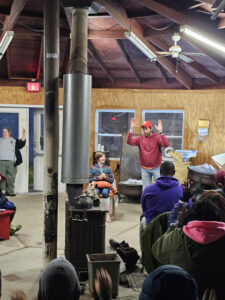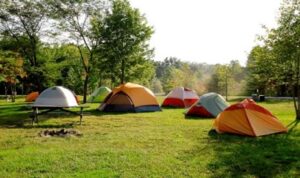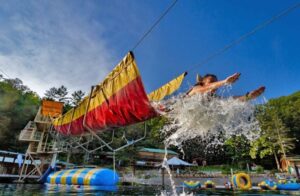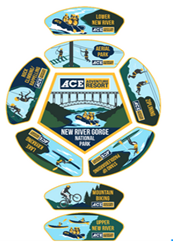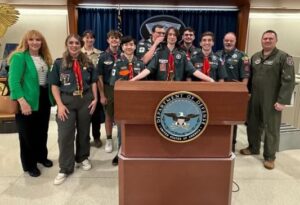 Venturing Crew 1345 of Burke, VA, embarked on an extraordinary journey to one of the most iconic buildings in the United States – the Pentagon. This visit was not just a tour of the five-sided headquarters (which the Crew counted to actually be 72 sides!) but a cool experience where they learned about different careers and government efforts.
Venturing Crew 1345 of Burke, VA, embarked on an extraordinary journey to one of the most iconic buildings in the United States – the Pentagon. This visit was not just a tour of the five-sided headquarters (which the Crew counted to actually be 72 sides!) but a cool experience where they learned about different careers and government efforts.
The Crew members were particularly interested in the building’s significance. During their visit to the interior 9/11 memorial, a Crew member noted, “It was interesting how it commemorated all the people who were lost during 9/11, and how all their stories were shared through books and signed pieces of paper.” Walking through the various corridors dedicated to each of the military branches and major historical events, the Crew delved deeper into U.S. history and gained insights into the history of the individual branches.
Thanks to the Crew’s adult leaders, who are active in the military, the Scouts were able to have a more personalized tour and had the chance to meet with individuals serving in various military positions. These interactions provided the Crew with a deeper understanding of the diverse roles within the military and the people who fulfill them. Among these roles were a Flight Nurse and a Strategist, which aligned with the career interests of some Crew members. The flight nurse shared insights into the challenges and rewards of providing medical care and transporting the injured in military aviation, discussing the required training, the critical decision-making involved, and the significant impact they have.
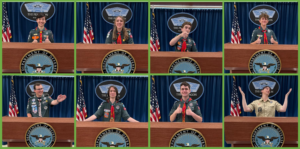
Beyond the specific roles, the visit to the Pentagon opened the Crew’s eyes to a multitude of career opportunities within the military. Each person they talked to emphasized the importance of leadership, teamwork, and dedication – qualities that are important to the Venturing program. When leaving the Pentagon, the Crew was especially surprised to see Venturing BSA trading coins in the Fort America shop (Pentagon gift shop)! The Crew’s visit to the Pentagon was definitely a highlight of the Crew’s year and one they will be talking about for a while.

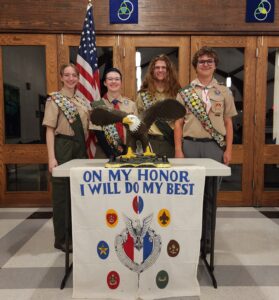

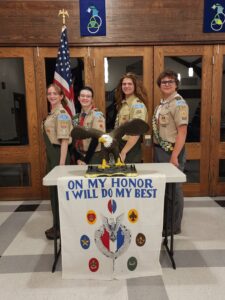
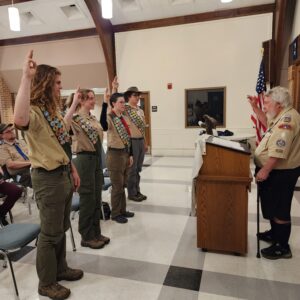
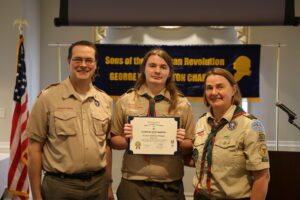 Troop 1577 Eagle Scout Russell Welland was recognized by the George Washington Chapter of the Sons of the American Revolution on May 11. He participated in the Arthur M. & Berdena King Eagle Scout Contest, and his essay was chosen for recognition by this chapter. At their monthly meeting, he read his essay and received a $500 scholarship.
Troop 1577 Eagle Scout Russell Welland was recognized by the George Washington Chapter of the Sons of the American Revolution on May 11. He participated in the Arthur M. & Berdena King Eagle Scout Contest, and his essay was chosen for recognition by this chapter. At their monthly meeting, he read his essay and received a $500 scholarship. To participate in this contest, Eagle Scouts write a 500-word essay about an aspect of the American Revolution. They must also document their family tree for four generations. In addition, they can earn additional points if they have earned these merit badges: American Heritage, Genealogy, and Law.
To participate in this contest, Eagle Scouts write a 500-word essay about an aspect of the American Revolution. They must also document their family tree for four generations. In addition, they can earn additional points if they have earned these merit badges: American Heritage, Genealogy, and Law.
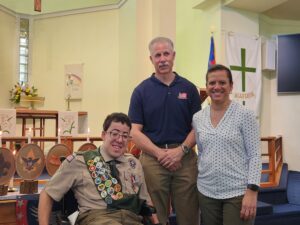 Aquia District Troop 850’s Newest Eagle Scout – Thomas Gill
Aquia District Troop 850’s Newest Eagle Scout – Thomas Gill Eighteen-year-old Thomas Gill celebrated earning the BSA rank of Eagle Scout on Saturday, April 20th, with a ceremony and reception held at Redeemer Lutheran Church in Fredericksburg, Virginia. Local leaders, State Senator Tara Durant, Delegate Paul Milde, and Senior Vice Commandant of the Marine Corps League, Jack Maas Detachment, Christina Wanzer, attended the ceremony and honored Thomas with commendations.
Eighteen-year-old Thomas Gill celebrated earning the BSA rank of Eagle Scout on Saturday, April 20th, with a ceremony and reception held at Redeemer Lutheran Church in Fredericksburg, Virginia. Local leaders, State Senator Tara Durant, Delegate Paul Milde, and Senior Vice Commandant of the Marine Corps League, Jack Maas Detachment, Christina Wanzer, attended the ceremony and honored Thomas with commendations.

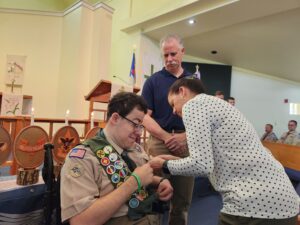 Thomas started his Scouting career as a Cub Scout in the National Capital Area Council Pack 845 while in the second grade. According to Thomas’ Mom, Elba, Thomas’ Cub Scout Pack Leader, “Joe Hernandez, an active-duty Marine, encouraged Thomas to always do his best and never give up and it worked!” Thomas says he joined Troop 850 “because they welcomed me without anyone asking what was wrong with my legs.” He went on multiple camping trips and hikes with his Troop, including a ten-miler at Gettysburg. He held several leadership positions in Troop 850 including Historian and Chaplains Aide.
Thomas started his Scouting career as a Cub Scout in the National Capital Area Council Pack 845 while in the second grade. According to Thomas’ Mom, Elba, Thomas’ Cub Scout Pack Leader, “Joe Hernandez, an active-duty Marine, encouraged Thomas to always do his best and never give up and it worked!” Thomas says he joined Troop 850 “because they welcomed me without anyone asking what was wrong with my legs.” He went on multiple camping trips and hikes with his Troop, including a ten-miler at Gettysburg. He held several leadership positions in Troop 850 including Historian and Chaplains Aide.

